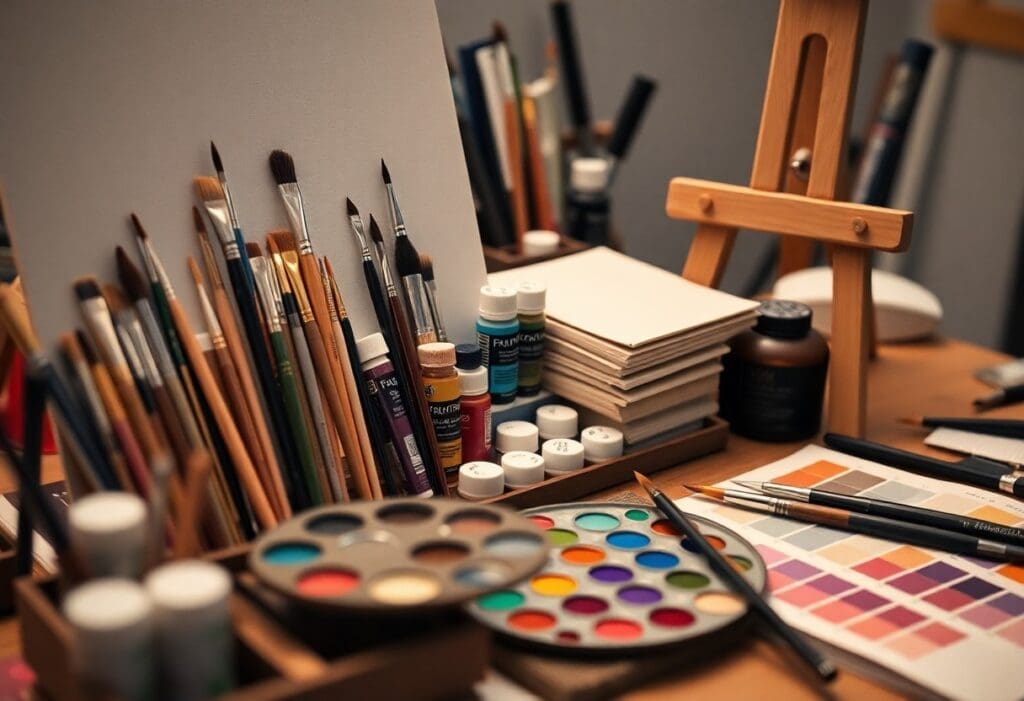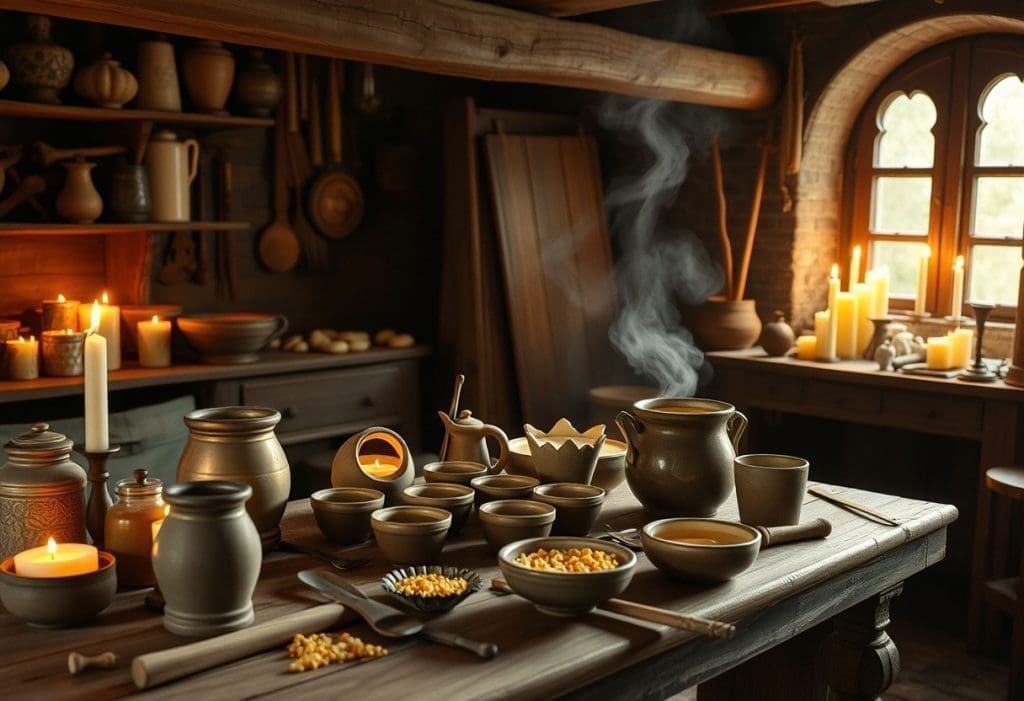You’re about to commence on an exciting journey into the world of painting, and you want to make sure you have the right painting supplies to get started.
Your first step is to gather the necessary tools and materials. With so many options available, it can be overwhelming.
Don’t worry, we’ve got you covered. We’ve narrowed down the must-haves to the top 10 painting supplies you need to get started.
In this post, we’ll walk you through the basics, from brushes to canvases, to help you set up your studio and begin creating your masterpiece.
Canvas or Panel
While choosing the right surface to paint on may seem daunting, it’s a fundamental decision that will impact your artistic journey.
As a beginner, you’ll want to consider the pros and cons of canvas versus panel.
Stretched Canvas Options
Some artists swear by stretched canvas, which provides a traditional, textured surface.
You can choose from cotton or linen, with cotton being the more affordable option.
More recently, we’ve seen some acrylic and synthetic canvases available and they’re good for starters, but seasoned painters will opt for a more natural backdrop to create their visions.
Panel Types and Sizes
Panel options offer a smooth, non-absorbent surface.
You can select from various materials like wood, board, or even paper-mounted panels.
| Material | Description |
| Wood | Natural, durable, and resistant to warping |
| Board | A cost-effective, eco-friendly alternative to wood |
| Paper-mounted | A budget-friendly option with a smooth finish |
| Yupo | A synthetic paper with a unique, non-absorbent surface |
The panel type you choose will depend on your personal preference and the style of art you’re creating.
Consider the texture, durability, and price point when making your decision.
- Wood panels are ideal for oil and acrylic paintings
- Board panels work well for watercolor and mixed media
- Paper-mounted panels are suitable for beginners or those on a budget
- Yupo panels are perfect for artists who want to experiment with unique textures
You’ll find that each panel type has its own unique characteristics, so be sure to experiment before committing to one
Painting Supplies: How to Pick Brushes
The right paintbrushes can make all the difference in the quality of your artwork.
Natural hair brushes
Hair-like fibers in natural hair brushes mimic the softness and flexibility of human hair. With these types of brushes, you’ll be able to execute smooth, even strokes and blending.
Synthetic fiber brushes
Any synthetic fiber brush you choose will provide excellent durability and resistance to wear and tear.
You can also expect synthetic fiber brushes to retain their shape well, even when used with thick or heavy paints.
Acrylic Paint Set
Assuming you’re new to painting, start by picking up a good acrylic paint set. Many artists consider it the foundation of their artistic journeys.
A well-rounded set will provide you with a variety of colors to experiment with and help you develop your skills.
Primary color selection
On the most basic level, you’ll need a set that includes the three primary colors: red, yellow, and blue.
You can mix these colors to create a wide range of hues and shades, giving you endless possibilities.
Earth tone additions
Color your world with earth tones! A good, full paint set will also include earthy shades like ochre, sienna, and umber.
These colors will help you create rich, natural hues and add depth to your artwork.
With earth tones, you can create landscapes, still-life compositions, and even portraits that exude warmth and coziness.
They’re also great for adding texture and dimension to your paintings. Experiment with different combinations to find the perfect shade for your artistic vision.
Palette for Mixing
Despite what you may think, a palette is more than just a surface to mix colors on.
It’s a tool that helps you organize your paints, test colors, and create harmonious combinations.
As a beginner, you should absolutely invest in a good palette. It will make a significant difference in your painting experience.
Disposable Palette Options
Perhaps you’re just a beginner dipping your toes in the world of painting. If that’s the case, you can even consider disposable palettes.
While these are certainly affordable, you can find “keeper” palettes for only a little more money. Why take the cheap-o route when you don’t have to spend much more to have something that will last?
Of course, you may disagree with that comment.
If you can find something on clearance for pennies on the dollar, maybe disposable palettes will work for you.
Whatever you choose, it will work out in the end.
Reusable Palette Materials
Reusable palettes are the most popular choice among artists, and for good reason.
They offer a durable, long-lasting surface that can withstand heavy use and cleaning.
Plus, reusable palettes made from materials like porcelain, plastic, or wood provide a smooth surface that allows for easy paint mixing and blending.
You can also customize them to fit your personal preferences, making them a great investment for your artistic journey.
Water Cup and Rags
All artists need a reliable way to clean their brushes and remove excess paint. That’s where a water cup and rags come in.
Water Container Options
The type of water cup you choose will depend on your personal preference and the size of your workspace.
You don’t have to spend a lot of money on this item. A plastic cup works great, or a cheap porcelain mug you can pick up from the clearance rack or a thrift shop suffices as well.
Lint-Free Rag Selection
If you’re looking for a rag that won’t leave behind pesky fibers, opt for a lint-free option.
For instance, microfiber cloths are an excellent choice because they’re gentle on your brushes and can absorb a lot of liquid without falling apart.
Easel for Support
When you have a good easel, you’ll be able to get the most enjoyment possible from your painting experience.
An easel provides the necessary support for your canvas or other painting surface, allowing you to focus on your art without worrying about it toppling over.
Tabletop Easel Options
Tabletop easels are perfect for small spaces and offer great flexibility.
You can easily set one up on a desk or table, providing a comfortable painting surface.
Standing Easel Choices
If you prefer to stand while painting, consider investing in a standing easel.
These tall, sturdy easels allow you to work at a comfortable height, reducing fatigue and strain on your back.
The standing easel’s adjustable height feature enables you to customize it to your preferred working position.
This is particularly useful if you’re planning to work on larger canvases or need to switch between sitting and standing throughout your painting session.
You’ll find a whole range of available options from professional to premium to lower cost and portable easels. Select what works best for the dimensions you need to mount and your budget.
Palette Knife Set
After selecting your paints, it’s time to think about the tools you’ll use to apply them.
A palette knife set is a must-have for any beginner painter.
Flexible Knife Options
With flexible palette knives, you can achieve smooth, blended strokes and subtle texture variations in your artwork.
Rigid Knife Uses
Assuming you want to add bold, thick textures to your painting, rigid palette knives are the way to go.
Rigid knives allow you to apply heavy, impasto strokes with confidence, creating dramatic, three-dimensional effects.
You can also use them to scrape and remove paint, revealing underlying layers and adding an element of unpredictability to your work.
Painting Smock
Many beginners overlook the importance of protecting their clothing while painting, but it’s a must-have for any serious artist.
Protective clothing options
Now that you know you need protection, you’re probably wondering what your options are.
Apron alternatives
Protective garments come in various forms, and aprons are just one of them.
A popular alternative to aprons is a painting smock, which provides full-body protection from stains and splatters.
Ruler and Measuring
For any painting project, accuracy is key. That’s where a ruler and measuring tools come in.
Straightedge uses
Rulers serve as both great measuring tools and straightedges for painting.
Once you have a ruler, you can use it as a straightedge to draw precise lines and edges in your painting.
Of course, any solidly-built and straightedge hard item will suffice, but a ruler is just easy to move and position, so it’s a go-to for many an artist.
Measuring tool options
The type of measuring tool you choose will depend on the specific needs of your project.
Ruler, tape measure, or caliper – each has its own strengths and weaknesses.
A ruler is perfect for small-scale projects and precise measurements, while a tape measure is better suited for larger projects that require longer measurements.
A caliper, on the other hand, provides precise measurements down to the smallest detail.
You’ll want to consider the size and complexity of your project when choosing the right measuring tool for the job.
Summing up: Must-Have Painting Supplies
Once you gear up with all of the above, you will have the foundation to set up your painting space with the top 10 must-have supplies for beginners.
Your journey to creating amazing artwork starts with these basics, and you’ll be well on your way to exploring different techniques and styles.
You’ve taken the first step by investing in these fundamental tools. Now it’s time to get creative and make art that reflects your unique perspective.



